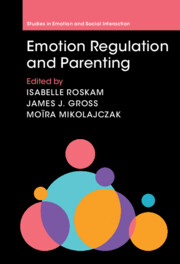Book contents
- Emotion Regulation and Parenting
- Studies in Emotion and Social Interaction
- Emotion Regulation and Parenting
- Copyright page
- Contents
- Figures
- Tables
- Contributors
- Preface
- Part I Conceptual Foundations
- Part II Influence of Parents’ Emotion Regulation on Parenting
- Part III Influence of Parenting on Child Emotion Regulation
- Chapter 7 Parental Coregulation of Child Emotions
- Chapter 8 Parental Assistance with Children’s Extrinsic Emotion Regulation across Development
- Chapter 9 Parental Socialization of Children’s Emotion and Its Regulation
- Part IV Current Trends
- Index
- Studies in Emotion and Social Interaction
- References
Chapter 7 - Parental Coregulation of Child Emotions
from Part III - Influence of Parenting on Child Emotion Regulation
Published online by Cambridge University Press: 05 January 2024
- Emotion Regulation and Parenting
- Studies in Emotion and Social Interaction
- Emotion Regulation and Parenting
- Copyright page
- Contents
- Figures
- Tables
- Contributors
- Preface
- Part I Conceptual Foundations
- Part II Influence of Parents’ Emotion Regulation on Parenting
- Part III Influence of Parenting on Child Emotion Regulation
- Chapter 7 Parental Coregulation of Child Emotions
- Chapter 8 Parental Assistance with Children’s Extrinsic Emotion Regulation across Development
- Chapter 9 Parental Socialization of Children’s Emotion and Its Regulation
- Part IV Current Trends
- Index
- Studies in Emotion and Social Interaction
- References
Summary
Emotional development can be described as the emergence of a child’s self-regulation out of coregulation by their caregivers, especially parents. This chapter highlights this transition, focusing on two interwoven facets of emotional development: the regulation of actions by emotions and the regulation of emotions by volitionally applied actions, called reflective emotion regulation. The significance of parental coregulation strategies is considered, specifically how they contribute to the differentiation of emotion qualities throughout ontogenesis as well as to a conceptual awareness of a child’s own elicited feelings and the inferred feelings of others, which is required for reflective emotion regulation. The chapter addresses core parental strategies such as context selection and modification, affect mirroring, modeling, reflective functioning and talking about emotions as well as levels of coregulation, and also presents a brief overview of the field. The chapter closes with a look at noteworthy issues for further research.
- Type
- Chapter
- Information
- Emotion Regulation and Parenting , pp. 129 - 148Publisher: Cambridge University PressPrint publication year: 2023



